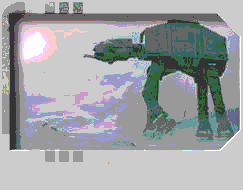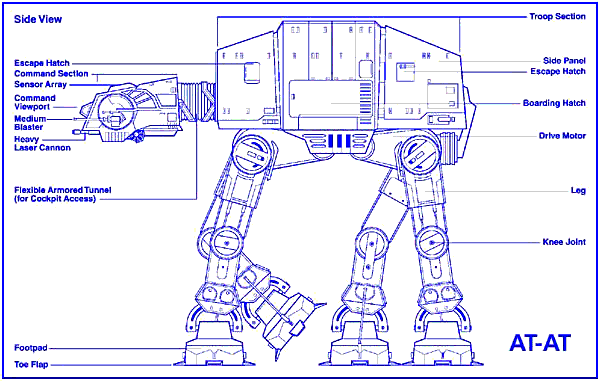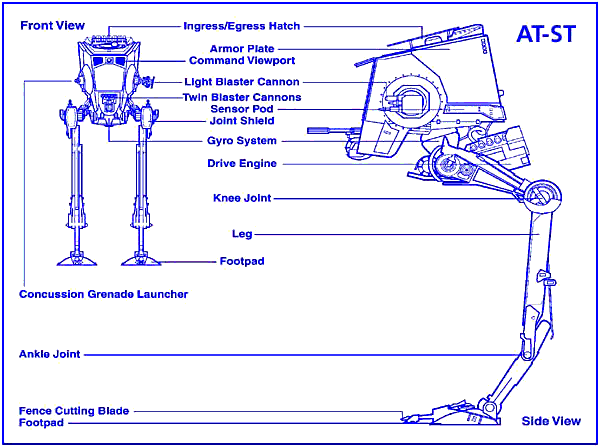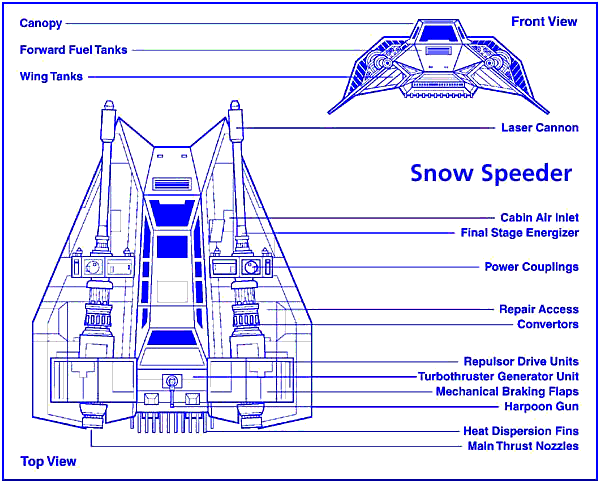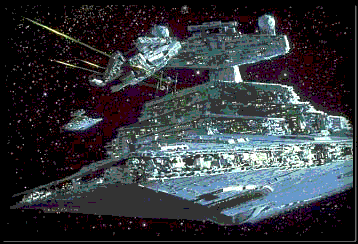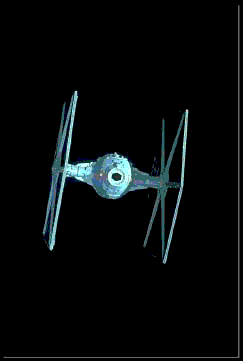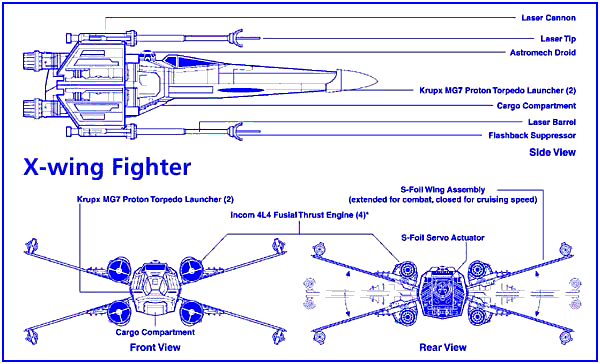|
|
|
A combat and transport vehicle, the immense four-legged Imperial All Terrain Armored Transport is as much a psychological weapon of terror as an actual weapon of destruction. More than 15 meters tall and 20 meters long, it can stride across a flat battlefield at up to 60 kilometers an hour and lob heavy laser fire from the cannons mounted beneath its "chin" while providing supporting fire from two medium blasters on each side of its head. Its armored body can offload 40 heavily armed troopers and five speeder bikes. Their thick plating shields them from all but the heaviest of artillery fire. Their heads can rotate, providing the commanding officer, pilot and gunner a sweeping view of any battlefield from the command deck. A T-ATs are usually among the first vehicles to enter a combat zone. Their heavy, crushing feet can cause the ground to shake before they even appear, frightening and demoralizing the enemy. They are the main weapon that General Veers employs during the Imperial assault on Hoth.
|
|
|
|
The relatively lightweight and speedy All Terrain Scout Transport (AT-ST) is used by Imperial forces for reconnaissance and ground support for both troops and the larger AT-AT walkers. Although smaller than AT-ATs at about 8.6 meters tall, they are significantly faster: on flat terrain they can move along at a 90-kilometer-an-hour clip. The two-legged walker has a small but highly maneuverable armored command pod that houses a pilot and a gunner. Each leg has a sharp claw that can slice through natural or man-made obstacles. With just two legs and a gyro balance system that is highly susceptible to damage, the AT-ST is more prone to tipping over than the AT-AT. But its flexibility and fire power make it a strong addition to the battlefield. Scout walkers are often used to lay down a blanket of covering fire for Imperial ground troops and for defending the flanks and somewhat vulnerable underbelly of AT-ATs. Its two-man crew enters and exits through a hatch atop the armor-plated command cabin.
|
|
|
|
From outward appearances "a piece of junk," this Corellian stock light freighter is one of the fastest and bst equipped crafts in the galaxy, when some malfunction or other isn't giving its crew headaches. That crew is daredevil pilot Han Solo and his Wookiee co-pilot and engineer, Chewbacca. The Millennium Falcon may look old and battered, but constant modifications turn it into a ship capable of going up against the Empire's most fearsome weapons.The Falcon had a number of owners before it fell into the hands of rogue gambler Lando Calrissian, who then lost it in a sabacc game to Solo. The dilapidated exterior of the ship helps Solo avoid at least some Imperials and Customs entanglements. Beneath the skin of the 27-meter long, Corellian Engineering YT-1300 transport is a hyperdrive nearly twice as fast as any Imperial warship. The The well-armored Falcon has a top-of-the-line sensor array to detect distant Imperial ships before they ever notice the Falcon. There are shielded smuggling compartments throughout the interior. In combat, the Falcon sports a military-grade Imperial deflector-shield system, two quad laser cannons and two concussion missile launchers, along with a retractable light laser cannon.
|
|
|
|
A dozen of these modified airspeeders become the Rebel Alliance's last line of defense when Echo Base on Hoth is assaulted by Imperial walkers. Nicknamed "snowspeeders," they delay the Imperial onslaught long enough to let the Alliance leaders escape. Snowspeeders are powered by a pair of repulsorlift drive units and high-powered afterburners. Mechanical braking flaps located above each repulsor engine housing assist in tight maneuvers. Snowspeeders can go more than 1,000 kilometers per hour, with an effective combat speed of about 600 kilometers per hour. While they lack shields, their compact size and speed make them hard to target. For combat duty, snowspeeders are fitted with heavy armor plating and twin laser cannons. A snowspeeder seats a forward-facing pilot and a gunner who sits with his back to the pilot. Computerized targeting systems allow the gunner to target the forward laser cannons. Against the heavy armor of the lumbering Imperial AT-ATs, the snowspeeder lasers can cause little damage, and Commander Luke Skywalker must resort to more innovative tactics to delay the invasion of Echo Base. A rear-mounted harpoon gun with tow cable serves the snowspeeder for cargo sled retrieval and hauling. Luke Skywalker puts this into use against the AT-ATs-or plans to, until his ship is shot down in battle. It is then up to fellow Rogue Squadron pilot Wedge Antilles to try for the first victory of snowspeeder against Imperial walker.
|
|
|
|
Warship construction is a lengthy, complicated business. The pre-construction phase alone - original inception, funding, design, creation of production facilities, training of personnel, and requisition of materials - can, for a large ship, take years; the actual construction of the vessel usually isn't much faster. The expenses are excessive, in both money and labor. As one might expect, the pressure on the ship designers and architects is enormous; the bureaucratic infighting and political wheeling, dealing, and budgetary battling is unbelievable. Once a project is approved and work on the vessel begun, the Empire is committing itself to that vessel for the next several decades. At that point, any changes - even trivial ones - in the vessel's design can cost literally billions of credits and thousands of extra man-hours. When Lira Wessex, daughter of the designer of the Victory-class Star Destroyer, proposed that the Empire produce the Imperial-class Star Destroyer, the angry debate between the Navy's military strategists, the Imperial Military Oversight Commission, and the Senate Budgetary Committee (since disbanded) almost destroyed the Empire. Some believe the Imperial too expensive, some believed it too unwieldily, others quite simply thought it was an engineering impossibility. The Navy loved it, of course; and through a combination of bribes, political pressure, and a rash of mysteriously crushed tracheas, it slowly brought the others into line. Years later, when the first Imperial-class ship lumbered out of drydock (only 50 million credits over budget) and assumed active duty, the Navy was proven correct in its belief. The Imperial-class Star Destroyer has enough firepower to reduce a civilization to slag or take on a fleet of enemy vessels. Each carries a full stormtrooper division, complete with assault craft and ablative heat-shield for orbital drops, 20 AT-AT and 30 AT-ST walkers for ground assault, and six TIE fighter squadrons for escort and patrol. There are whole star systems whose gross domestic product is less than the cost of a single Star Destroyer. There are whole nations which, throughout their entire history, do not use as much energy as a Star Destroyer expends to make a single hyperspace jump. The galaxy is huge; even the Empire has never visited a majority of the stars within it. Controlling it all is impossible. The best that can be hoped for is to frighten all into submission with the threat of destruction - and swiftly and ruthlessly crush any opposition that appears. The Imperial Star Destroyers are the weapons the Emperor uses to rule the galaxy. By deploying a Star Destroyer and support ships to a system, the Empire can destroy virtually any foe. It would be impossible to garrison every system in the Empire - but its Star Destroyers give the Empire the ability to project its power anywhere it wishes on short notice. Much of the Imperial Navy is permanently deployed in reserve in the Galactic Core, ready to swiftly respond to any threats, anywhere. The Imperial Navy is organized into fleets, which are composed of one Imperial-class Star Destroyer accompanied by support and lesser combat ships. Each fleet can operate independently. In practice, Star Destroyers can be combined in Task Forces of three, Sector Squadrons of six, or Regional and Territorial Fleets of 24 - but it is unusual for more than one to occupy the same star system, except for ceremonial purposes. Such concentrations of force are rarely necessary - there are few things which can seriously challenge even one Star Destroyer. An Imperial Star Destroyer is more than a weapons platform: because of the variety of its duties - planetary defense, planetary assault, and ship-to-ship combat - it must also be something of a space station, repair dock, and heavy transport as well. In addition to combat craft, an Imperial Star Destroyer carries eight Lambda-class shuttlecraft and many repair and recovery vehicles. Since they are not designed to enter planetary atmospheres, each Star Destroyer also carries 12 landing barges for crew and cargo transfer and for ground assault. Landing barges are shielded and armed, and carry up to four AT-AT's (or eight AT-STs) and 1,000 troops each. They can also haul the heavy weapons, supplies, and equipment required for planetary operations. Many Star Destroyers carry complete pre-fabricated ground bases, which can be dropped and installed within days. When a base is deployed, the Star Destroyer dispatches 800 troops, 2,200 support personnel, 10 AT-ATs, 10 AT-STs, and 40 TIE fighters as a garrison. Of course, space combat is their main duty, and Star Destroyers are well designed for it. Turbolasers and ion cannons are mounted in five-gun batteries. Each battery contains three turrets, two of which are double-mounted, and one single-mounted. The turrets can jointly target a single enemy ship to concentrate firepower, or fire independently to engage multiple targets. However, the placement of the batteries is a weakness: there were few overlapping fields of fire at close range. While this is no great problem in actions against larger capital ship opponents, it is a drawback when fighting small and highly maneuverable ships, which can dart under the guns. Naturally, most Imperial Star Destroyers carry TIE fighters to deal with small opponents; this fiscal year's Imperial budget provides funds to retrofit the remainder with TIE flight decks. However, in light of the disaster at Yavin, funding may be diverted to more vital purposes.
|
|
|
The TIE fighter is the most recognizable symbol of the Imperial Navy's control of space. TIE (Twin Ion Engine) fighters are aboard even the smallest cruisers and are stationed at starports and garrison bases across the galaxy. The TIE fighter is a small ship whose distinguishing feature is the pair of large hexagonal solar array wings on either side of its small, spherical cockpit pod. The ship presents a small profile and its great maneuverability makes it difficult to target in combat.TIEs are short-range fighters lacking hyperdrives to save weight and increase performance. They depend on a home base--a nearby planet or Imperial cruiser. They carry two days' worth of supplies and must refuel after the first few hours of combat, but their massive quantities make up for any design deficiencies. The fighters are used for planetary and cruiser defense and assault against Rebel, pirate and alien vessels.Each TIE has a pair of forward-mounted, fire-linked laser cannons.The powerful laser generators are in the undercarriage of the command pod and feed off the power generators and batteries. The fighter draws much of its energy from solar radiation absorbed by the array wings. |
|
|
|
|
One of the Rebel Alliance's most advanced fighters, the X-wing plays a major role in the assault on the first Death Star. The one-man T-65 X-wing starfighter, which measures 12.5 meters from nose to engine block, was the final design of its kind by the Incom Corporation before Incom was nationalized by the Empire.The X-wing takes its name from its pair of double-layered wings that are deployed into an X-formation for combat. During atmospheric and non-combat space flight, the wings are closed for stability. Each wing tip carries an oversized long-range laser cannon. A pair of proton torpedo launchers are mounted midway up the main space-frame, each holding a magazine of three torpedoes. An R2 astromech droid housed in a snug droid socket behind the pilot handles many in-flight operations, such as damage control, astrogation and flight performance adjustment.The X-wing is known for its durability, with a reinforced alloy hull and high-powered shield generators. It can normally take minor hits without a serious loss of performance, and has full ejection and life-support systems. X-wings have hyperdrive systems that add flexibility to their list of attributes. |
|
|
|
Despite its age, this ship has been one of the mainstays of the Rebel Alliance and sees notable duty at the Battle of Yavin. The twin-engine Y-wing, at 16 meters long, is a multi-purpose ship designed as a compromise between an attack fighter and heavier bombers. The well-armed and durable Y-wing fighter-bombers can give and take a great deal of punishment, but they do not have the speed and maneuverability necessary to compete evenly with modern Imperial attack fighters.The Rebel Alliance has flown more Y-wings than any other fighter and has used a number of different configurations for a variety of mission profiles. It is not uncommon for a Y-wing to be stripped down for assault runs against Imperial convoys and then be refitted by Rebel technicians for a heavy bombing run against an Imperial base. Y-wings also find use on diplomatic escort missions and for long-range patrols. The Y-wing has three main components. The forward cockpit nose cone houses the pilots and weapons systems. A reinforced space-frame central spar stretches back from the nose cone; the Y-wing's ionization reactor and hyperdrive/astrogation hardware are crammed into this narrow frame. A cross wing housing the main power cells attaches at the back of the spar, with the two powerful turbine sublight ion drives on either end. The cockpit module is protected by sturdy armor plating. Hull plating originally covered the entire Y-wing body, but as the ship requires maintenance after virtually every flight, mechanics weary of constantly removing and replacing panels have finally left the body plating off entirely. The pilot controls a pair of forward laser cannons and the twin proton torpedo launchers. A turret-mounted ion cannon is directly behind the pilot, although the ion cannon is notoriously delicate and failure-prone. An astromech droid fits into the droid socket behind the cockpit and monitors all fight, navigation and power systems.
|
